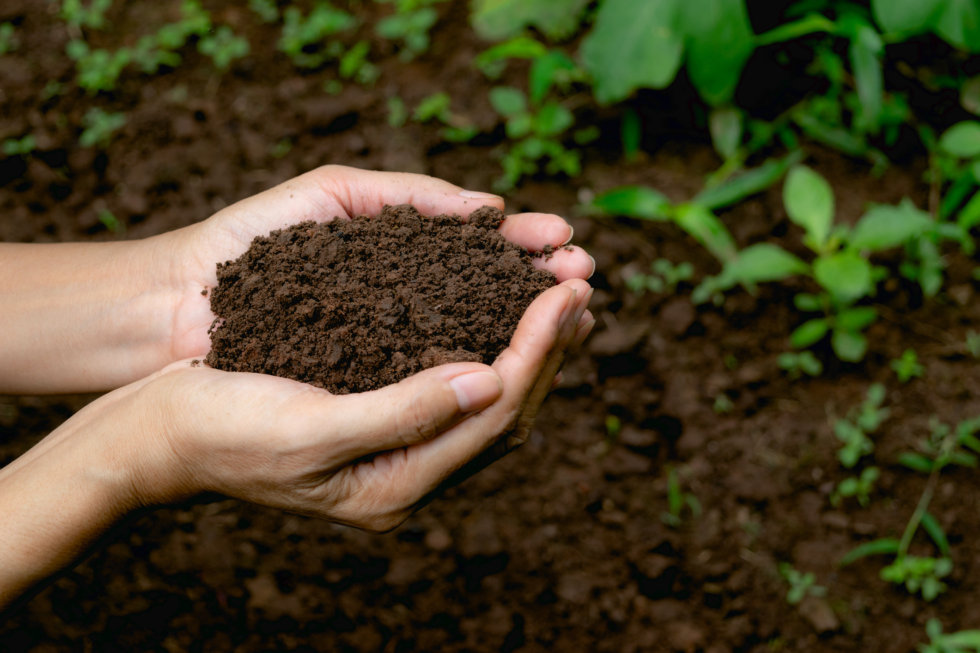
The secret to healthy, thriving plants lies in the soil. Many variables come into play when discussing what makes our landscape soils suitable to allow the plant life under our care to flourish. After decades of understanding, manipulating and planting in our local soils, Chip-N-Dale’s brings a wealth of expertise and knowledge on the topic of soil to your landscaping projects and plant installations.
Perhaps the most important attribute of soil in our opinion is its porosity. Porosity determines the soil’s ability to hold air and facilitate root respiration for the plants. Well-aerated soils allow roots to breathe and take in nutrients, promoting healthy plant growth. Loamy soils, with their perfect balance of sand, silt, and clay, offer excellent porosity. However, compacted soils can suffocate roots, leading to stunted growth and limited nutrient uptake. Regular tilling, adding organic matter, and avoiding soil compaction are essential steps to maintain optimal porosity.
Hand in hand with porosity, the delicate balance between water retention and drainage is vital for plant survival. Soils with good water retention keep plants hydrated during dry spells, while sandy soils quickly drain excess water, preventing root rot. To improve water retention in sandy soils, incorporating compost and organic materials can help retain moisture. Proper drainage is equally crucial, as poorly draining soils can drown plant roots. Ensuring a well-draining environment, such as in sandy loam soils, prevents waterlogged conditions that could lead to root diseases.
The presence of organic matter significantly impacts soil fertility and structure. Rich in nutrients, organic matter nourishes plants and fosters a thriving ecosystem of beneficial microbes. Soil teeming with organic material, like humus-rich loam, provides a steady supply of nutrients for plants. One must be careful about incorporating too much organic matter into soils containing drought-tolerant and desert-adapted plant life. These plants are accustomed to drier, sandier soil compositions and can suffer if surrounding soils contain withhold too much moisture.
Soil types are often classified as either Loam, Sand, or Clay, depending on the amount of organic matter and size of the inorganic particles. Loam is the ideal soil type, offering a favorable blend of larger sand particles, smaller clay particles and biodegradable organic matter. It provides the perfect environment for roots of traditional plants, with good water retention, drainage, and nutrient availability. Sandy soils, best suited for drought-tolerant plants as mentioned above, drain rapidly and require frequent watering and fertilization. Clay soils, while excellent at water retention, need proper amendments like gypsum to prevent waterlogging. Tailoring planting strategies based on soil types ensures the best environment for optimal plant growth.
Planting in arid landscapes presents unique challenges due to the harsh conditions of desert soils. Here in Southern Nevada, our most common soil type is a nutrient-poor, sandy composition filled with rocks, pebbles, gravel and other inorganic particles. These soils lack significant percentages of organic matter and essential nutrients. Occasionally we encounter chunks of compacted cement-like soils (termed caliche) or even pockets of clay composed of minute silty particles. Successful gardening in unamended desert soils is possible through selection of drought-tolerant and heat-resistant plants. Introducing organic matter and mulching to minimize evaporation are effective strategies to enhance desert soils for more traditional plants like roses and fruit trees.
A final note about planting in our soils: be aware that our harsh desert winds can uproot plants and trees that are not anchored properly in the soil. Plant roots, particularly those of new unestablished plantings, shift more easily in rocky, gravel soils versus more tightly-packed compositions of smaller particles. Soils containing a variety of particle sizes offer the best compromise between keeping a plant in place and allowing water to drain away from the root zone.
